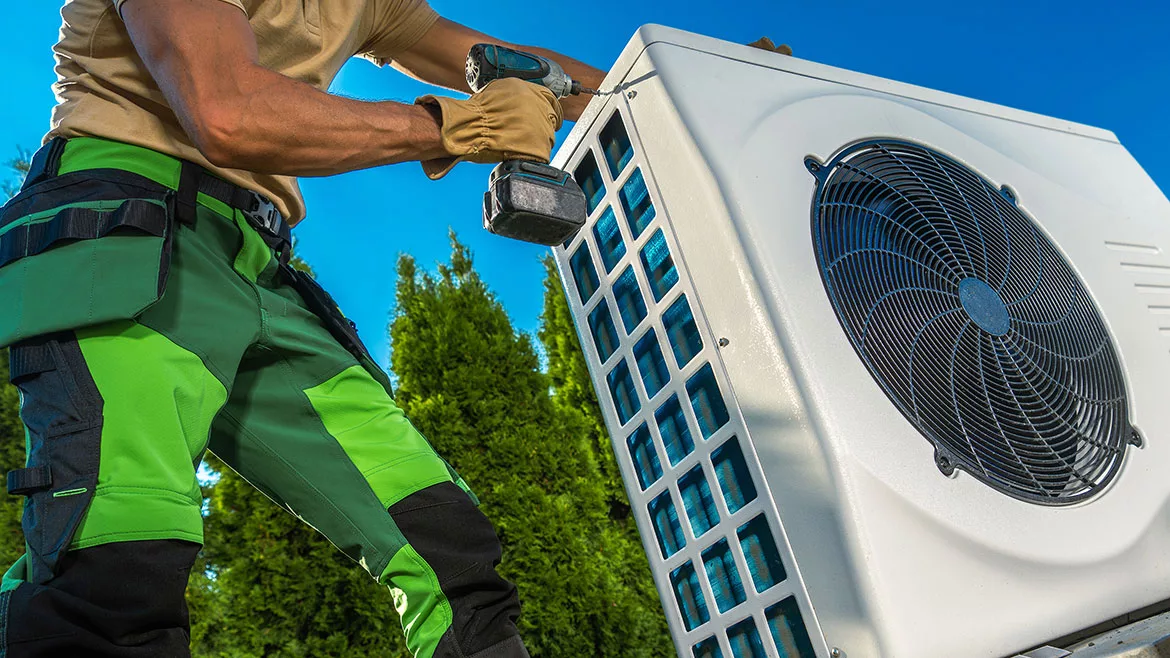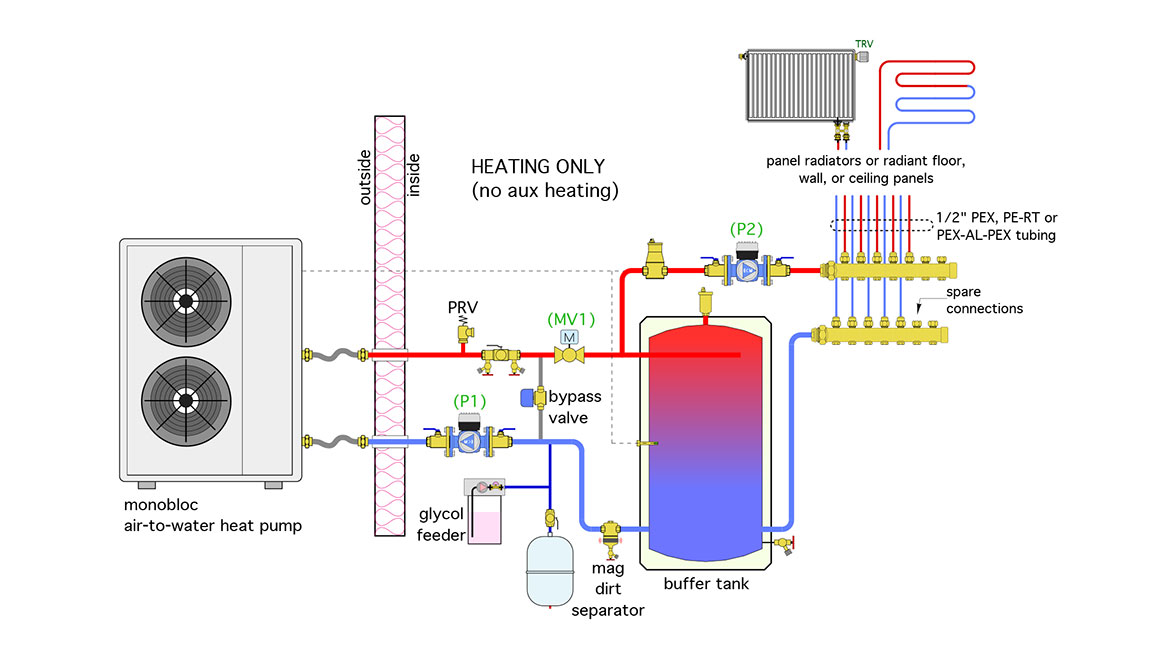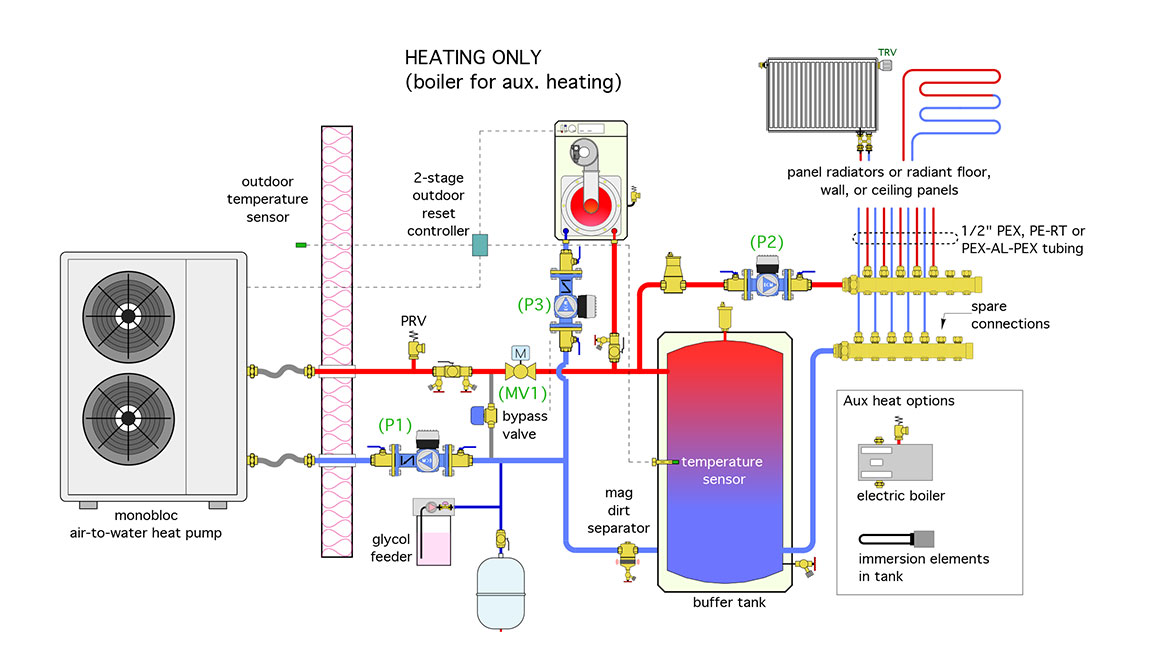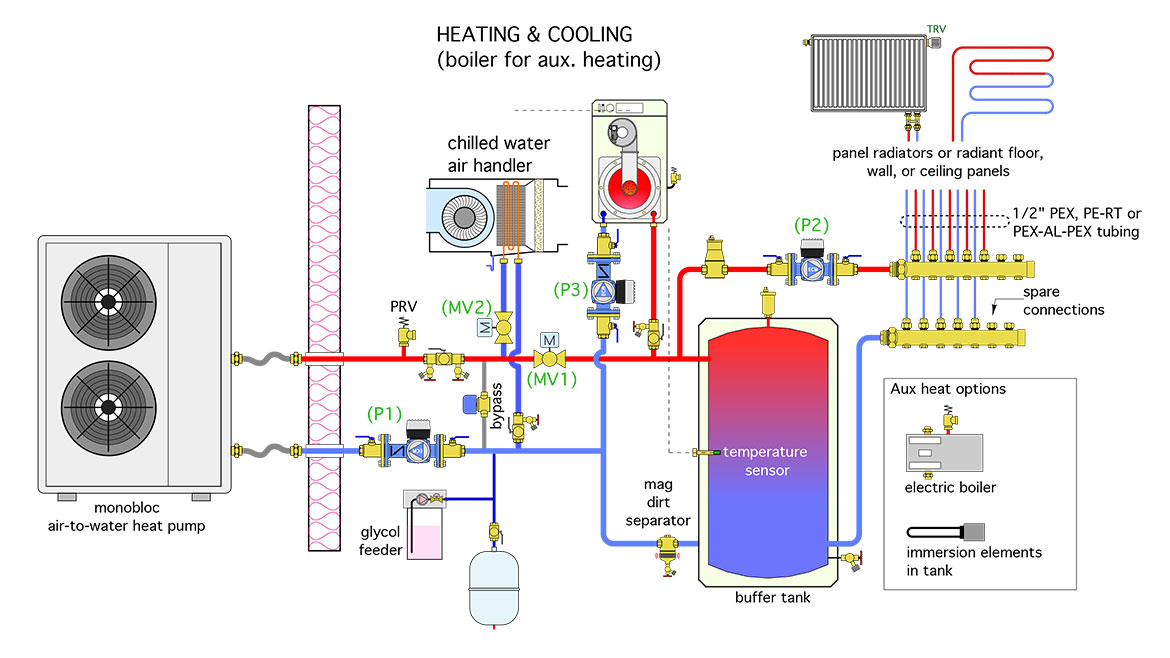Hydronics Workshop | John Siegenthaler
Adding functionality to heat pump systems
Expanding a concept — part one.

Lead image courtesy of welcomia / iStock / Getty Images Plus
One “ingredient” needed to bolster acceptance of air-to-water heat pumps is standardized piping layouts that can be used with the majority of the heat pumps now available in North America. To that end, let’s start with a very basic heating-only system, and show how the piping topology used for that system can be expanded to add functionality, such as auxiliary heat, cooling and domestic water heating.
Single task
The system shown in Figure 1 is based on a monobloc air-to-water heat pump as the sole heat source for a space heating system.
FIGURE 1


When the system is active, the heat pump maintains the temperature in the buffer tank based on outdoor reset control. This optimizes the heat pump’s thermal performance by only allowing the system’s fluid to reach a temperature that can meet the building’s current heating load. The warmer the outdoor temperature, the lower the required fluid temperature in the system.
Most manufacturers of monobloc air-to-water heat pumps require they be operated with an antifreeze solution. This protects them from freezing during prolonged power outages in subfreezing weather. Perhaps less obvious is preventing potential freezing in the heat pump’s evaporator if the unit was operated in cooling mode during cool outdoor temperatures. Granted this is not a common occurrence, but it is possible for several reasons, not the least of which is a control system “glitch.”
To meet this requirement, the entire system is filled with a 30% solution of inhibited propylene glycol. This eliminates the need for a heat exchanger between the heat pump and balance of system.
If a heat exchanger is used between the heat pump and load, the heat pump must operate several degrees Fahrenheit higher than the remainder of the system to create sufficient temperature differential across the heat exchanger. The higher the delivery temperature of the heat pump, the lower its heating capacity and coefficient of performance.
One “nuance” that needs to be addressed when buffer tanks are used with air-to-water heat pumps is most of these heat pumps have internal controls that turn on their associated circulator (P1 in Figure 1) for two to three minutes prior to starting the compressor. This is done to “validate” that the flow passing through the heat pump is adequate and stable before operating the compressor.
If this initial flow passes through a buffer tank, it disrupts beneficial temperature stratification within the tank (e.g., warmest water at the top of tank and coolest water at the bottom).
To prevent this, the system in Figure 1 provides two motorized valves. The “bypass” valve opens as soon as the circulator turns on. This allows a flow path through the heat pump but doesn’t allow that flow to pass to the buffer tank. The motorized valve (MV1) remains closed until the outlet temperature from the heat pump rises slightly above the temperature in the upper portion of the buffer tank. In systems where the heat pump is located just outside the building, there isn’t a lot of fluid between the heat pump and the bypass valve. This allows the outlet temperature from the heat pump to rise quickly. Some heat pumps require a minimum fluid volume in the recirculation circuit. This minimum volume might be present in the piping leading to and from the heat pump. In other cases, it can be met be installing a small insulted tank - typically 5-10 gallons in the recirculation circuit.
The distribution system in Figure 1 is very simple. It uses a variable speed pressure-regulated circulator to supply a manifold station. That station could serve multiple panel radiators, each equipped with a thermostatic radiator valve. The circulator operates continuously in a constant differential pressure mode during the heating season, automatically adjusting its speed as the radiator valves open, close or modulate flow.
Another option is for the manifold to serve multiple radiant floor, wall or ceiling panels. Zoning could be accomplished by installing low-voltage valve actuators on the manifold station and wiring them to zone thermostats. It’s also possible to combine panel radiators, radiant panels and low-temperature convectors, all supplied at the same temperature from the manifold station.
Notice that there are a couple of “spare” connections on the manifold station. This allows for simple expansion of the heat delivery system, with very little increase in upfront cost. It’s an easy “upsell" to your customers.
The system “trim” includes:
- An expansion tank sized for the full volume of the system;
- An automatic fluid feeder for premixed antifreeze to maintain system pressure;
- A dual-port purging valve for forced fill and flushing of the system;
- An air separator and magnetic dirt separator to keep all heat exchanger surfaces clean; and
- A pressure relief valve to prevent excess pressure if the heat pump were isolated from the remainder of the system.
Add-a-boiler
All air-source heat pumps have less heating capacity as outdoor temperature drops. Depending on how the heat pump is sized relative to design load, the temperature requirement of the heat emitters, and the heat pump’s refrigeration system (standard or enhanced vapor injection), it may be possible for it to supply the full heating load at sub-zero outdoor temperatures.
Even with this ability, I maintain that it’s prudent to provide supplemental and backup heating. This could be done using a boiler or with immersion heat elements in the buffer tank.
The system in Figure 2 shows a mod/con boiler as the supplemental and backup heat source. Any boiler, new or existing, could potentially be used. A mod/con boiler or an electric boiler could be connected as shown in Figure 2. If a conventional boiler (e.g., one not intended to operate with sustained flue gas condensation) is used, a thermostatic anti-condensation valve should be installed to protect the boiler and its venting system from corrosion.
FIGURE 2


The boiler is piped in parallel with the heat pump. Either can serve as the sole heat source, or they can operate simultaneously if needed during peak loads. Each heat source has its own circulator with an internal check valve.
The heat pump would be operated by the first stage of a 2-stage outdoor reset controller. The boiler would only be operated by the second stage of this controller, if necessary, to maintain the required fluid temperature in the upper portion of the buffer tank. The 2-stage controller should have an interstage time-delay setting of at least five minutes to allow time for the heat pump to start up and stabilize before invoking the boiler.
Adding cooling
One of the unique benefits of using an air-to-water heat pump as a hydronic heat source is that it can also operate as a chiller for cooling.
A relatively simple approach to add cooling to the system is to supply chilled fluid to an air handler that, in turn, supplies a ducted delivery system. The air handler must be equipped with a condensate drip pan and drainage system.
The system in Figure 3 shows where to pipe in supply and returns for the air handler.
FIGURE 3


Another motorized ball valve (MV2) has been added to the supply piping to the air handler. This valve opens whenever cooling is called for, and the fluid temperature leaving the heat pump is 55° F or cooler. It also prevents flow through the air handler when the system is operating in heating mode.
The heat pump’s circulator (P1) must be sized to provide sufficient flow through the heat pump when operating against the head loss of the heat pump, the air handler coil and the piping in between. Be sure to check with the heat pump manufacturer to get the head loss curve and the minimum acceptable flow rate during cooling mode operation.
If the heat pump uses a single-speed compressor, the air handler’s cooling capacity needs to reasonably match the heating pump’s cooling capacity at a chilled fluid supply temperature in the range of 45° to 50° F. Undersized air handlers will cause a fixed speed heat pump to short cycle.
Fortunately, many of the air-to-water heat pumps now available in North America have variable speed (inverter) compressors that can adjust cooling capacity as necessary to hold a set chilled fluid supply temperature. This allows the air handler to be sized to smaller cooling loads when necessary, down to about 1/3 of the rated cooling capacity of the heat pump.
Be sure that all tubing and piping components that come into contact with chilled fluid are insulated and vapor-sealed to prevent condensation and subsequent dripping. Don’t cheat on the insulation quality or its installation. Any gaps where surrounding air can contact chilled water piping or components will result in condensate accumulation, and that will quickly lead to dripping, staining, and, eventually, to mold. Glue all joints in the insulation, and use adhesive-backed insulation tape when necessary to fit oddly shaped components. If available, install molded insulation shells on circulators and seal up all the seams.
What’s next?
So far, the system has been expanded from a single heat source providing space heating to a system with an auxiliary heat source that can provide space heating and cooling. I’m sure most readers can determine what other functionality needs to be added to fully address the thermal needs of a typical home. We’ll get into that next month, along with a “fourth” functionality that you may not have thought of yet.
Looking for a reprint of this article?
From high-res PDFs to custom plaques, order your copy today!






